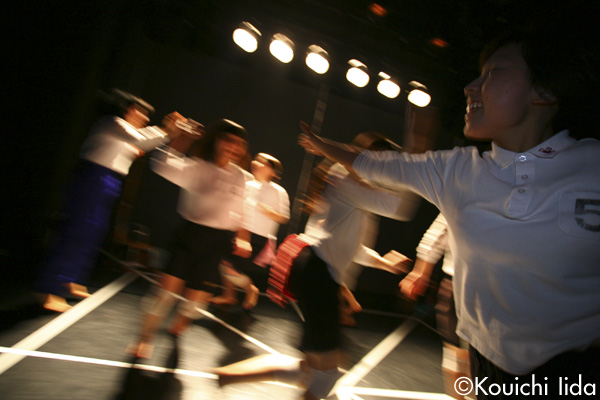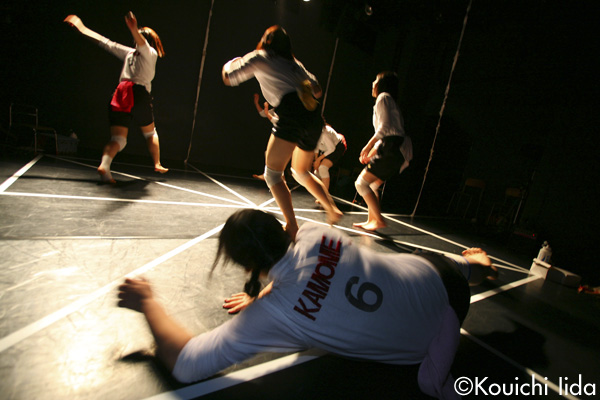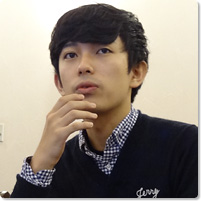Scene one opens with the beginning of one of the last games of the girls’ volleyball team. The scenes are divided into chapters and each chapter is narrated from a different person’s perspective.
The first chapter is told from the perspective of a girl named Runa who transferred from another school a year earlier. Runa’s memories prior to the game are recreated. The memories include a conversation with her close friend Shiho, who is feeling the pressure of being chosen the team captain, memories of an incident of a strange smell in the volleyball team’s locker room, recollections of the first day she came to the school, the words of Shiho when she invited Runa to join the volleyball team and the time she was treated like and intruder by a girl named Kiyo while receiving individual instruction the technique of shooting a spike.
In the second chapter different versions of the same experiences are depicted from Shiho’s viewpoint. Going back in time from the start of the game that opened the play, there is a scene where Shiho objects to a negative article written about the volleyball team by a girl named Yoshimi of the photography and newspaper club. There is a conversation with the soccer team member Hamada who appears at that moment. As she is walking toward the gymnasium’s storehouse, Shiho’s memory shifts to a scene of practicing for the previous year’s Sports Day. Then the damp and humid path she is evokes in her mind the image of a swamp with lurking crocodiles. In this elusion Yoshimi is a piranha, Hamada is a neotenic salamander and the inside of the storehouse is the belly of a crocodile. In the storehouse Shiho finds the wristwatch Runa had lost. As she returns the watch to Runa, Shiho asks her what she misses about former school in Tokyo. But, Runa replies that she ha already forgotten anything nostalgic.
The scene shifts again to the volleyball team’s locker room. It turns out that the source of the strange smell was a pork cutlet sandwich in the locker of the first-year student Nobue. As Shiho scolds Nobue she recalls that she was once scolded in just the same way by her senior and she suddenly gets the feeling that she is in the swamp again on a muddy path.
The third chapter is told from the perspective of the volleyball team’s manager, Makiko. There is a refrain about the strange smell incident. Going back in time we see Makiko running to the lavatory with intestinal distress and we learn that she previously didn’t belong to any after-school club because of her weak intestines. Several scenes are repeated in refrain fashion and they reveal the process by which Runa encourages Makiko to join the volleyball team as she had always longed to do.
Chapter four plays out from the perspective of Shiho. It begins with a narrative about her worries about being assigned the position of captain and progresses on to refrains about the first time she heads the spike practice. Next it moves on to the scene at the end of chapter one where Runa is being treated as an unwanted presence by Kiyo. To Shiho, who originally invited her to join the volleyball team, Runa pours out her feelings to about her joy at being a member of a sports team for the first time and her desire to continue practice. Then the two return to practicing.
Scene two. Chapter five is told from the viewpoint of Ajisai. There is a momentary refrain of Ajisai shooting a spike successfully. Ajisai’s memories flow in an unfocused manner, centering mainly on the boy she likes, Hamada. When the freshmen Chizumi and Nobue say something to her, she seems to be off in the clouds. Hamada has been asked by Yoshimi to take some pictures and he is juggling a soccer ball as he waits in the central courtyard. Ajisai and Yoshimi are childhood friends who live on the same commercial street in town, and Yoshimi harbors secretly feelings of love for Ajisai.
There is a refrain of Makiko rushing to the lavatory, followed by a conversation between Kiyo and Ajisai about a new McDonald’s that has opened near the school. Ajisai goes to buy something at McDonald’s but there she is overcome by a strange feeling of being in a foreign country. There are refrains of several scenes and in the midst of them we see clearly the feelings that are making Ajisai uncomfortable about being a with the volleyball team.
While some of the team members in the locker room are talking about the progress Runa is making on the team, Ajisai complains to Shiho that she is not feeling well and gets permission to take the day off from practice.
Chapter six is told from Nobue’s perspective. Nobue has been given a special training menu by Shiho as a penalty for the cutlet sandwich incident, but she is unable to take it and breaks down crying. She rejects Chizumi’s words of encouragement. To Makiko, who has been watching her from a distance, Nobue lets out her doubts about whether she will be able to keep up with the team.
Scene three. Chapter seven is told from Ajisai’s perspective again. She is recalling moments from the short two months when she dated the upperclassman Nikaido in the past. The times when she shared love stories with the other members of the team are also memories of the distant past.
Chapter eight is told from the viewpoint of Hamada. The scene is the morning commuter train the students take to school. We see how he meets Yoshimi at the station, how she asks him to take some pictures for her that day, and later an argument with Kiyo when she gets on the train. Everyone gets off at the station near the school except Hamada. Ajisai, who had been waiting for Hamada at the station, is dismayed when she learns he hasn’t gotten off.
Hamada meets Nikaido as planned at another station and is given a package. Hamada keeps walking on to the seashore and stares at a bone that has washed up on the beach. He happens to open the package he has been given by Nikaido and finds a pistol inside. He slowly raises it to his temple. Then, as if nothing had happened, he gets on the train again and heads to school.
Runa gets on the same train. Rain starts to fall and she and Hamada walk from the station to school sharing the same umbrella. Ajisai sees this from the classroom window.
With the sound of the girls’ volleyball team singing the school anthem in the background we see Hamada fiddling with the pistol. While trying to remember the name of the main character in Chekhov’s play
The Seagull
, he pulls the trigger. But no bullet comes out of the toy pistol.
After practice, the girls’ volleyball team has taken Shiho’s suggestion that they all go to the public bath “Tengu” run by Yoshimi’s family.
The volleyball team members are joined by Hamada, which gets Yoshimi flustered. Around the same time, Ajisai is helping her grandfather get ready to go to the public bath Tengu, which is the only thing he ever leaves the house for.
Chapter nine is told from the standpoints of Chizumi and Yoshimi. Chizumi comes to see Yoshimi while she is developing some pictures in the Photography Club’s darkroom. She has asked Yoshimi to develop some pictures of guppies. Nobue also arrives, carrying a bucket of guppies that died in a science experiment. Before leaving, Yoshimi takes pictures of the dead guppies with them.
In a classroom Hamada is reading a magazine. Yoshimi comes to ask him once again to take some picture for her. After some arguing the two finally reach an agreement. As they head toward the courtyard, Makiko comes running by on her way to the lavatory. Hamada tells Yoshimi to go on ahead and crosses the playground to where Nikaido is standing.
There is a series of refrains of scenes including Shiho on her way to the gymnasium storeroom, Ajisai before she does to McDonald’s and the foul smell incident.
The two freshmen are burying the dead guppies in a flowerbed. Chizumi is thinking about what dying means, about becoming free and about the fate of the guppies. On the way to practice Chizumi thinks to herself, “School is like the inside of a fish tank.”
A series of refrains of scenes of all the characters actions since chapter one are repeated across the entire stage amidst glimmering lighting effects. When it reaches the start of the volleyball game the stage lights go out.
Scene four. The team loses the first set due to a mistake by Kiyo. During the rest interval they rethink their game strategy, then huddle for a cheer before returning to the court. Shiho’s memory returns to the night they went to the public bath Tengu.
We find Yoshimi and Hamada after the bath. Hamada teases Yoshimi, saying that both her body and face resemble those of a middle-aged man and in the end he adds the insult of saying that it is because she is destined to be the operator of her family’s public bath in the future. In a tiff, Yoshimi grabs Hamada blurts out the fact that their public bath is going to be torn down and that she is in love with Ajisai. Hamada throws her off and starts to leave, with Shiho following behind. Hamada also has his own emotional hang-up concerning his complex feelings about his father who lives separated from the family.
Ajisai is walking through the business district where she lives and runs into Yoshimi fresh from her fight with Hamada. Ignoring Yoshimi’s concerns, Ajisai walks on into the night streets. Yoshimi follows her. Eventually the two walk all night and end up at the seashore. Ajisai can’t decide whether to continue with the volleyball team or not. She scatters her grandfather’s ear swabs across the sand.
Meanwhile, with Ajisai absent, the first day of the volleyball team’s retreat is coming to an end. The volleyball team members are having a debriefing session. After lights-out, the scene jumps to the morning of the second day of the retreat and we find Shiho and Runa have gone to the beach.
The early morning sea. Shiho asks Runa if she remembers the first time they practiced spikes together. After this, scenes of each character’s memories appear one after another as refrains. Between each of these scenes we hear Shiho asking, “Do you remember?” The scene returns to the beach, where Runa breaks the news to Shiho that she has to change schools again, and that her debut match with the team will also be her last match.
The scene returns to the team’s game as it enters the second set. Shiho and the team are losing points again. As the game nears its end Runa says, “Thank you for this last match” and leaves the court. After that the players leave the court one by one. As the game ends only Shiho remains. She bows, says thank you and leaves the court in tears.
Hamada is in the classroom. Ajisai comes in and invites Hamada to go with her to see the tearing down of the public bath Tengu. When Hamada refuses, Ajisai says, “What have we been after all this time?”
Yoshimi and Ajisai watch as the Tengu building is torn down.
The scene changes to a new town where Runa is walking down the street in her own clothes, instead of a school uniform. She takes her watch out of her bag and says simply, “It’s moving. The time outside.” From behind, the voice of Shiho calls her. Runa looks back once, then turns again and walks on.




